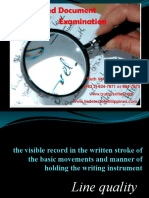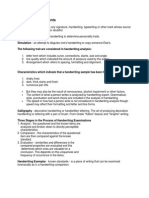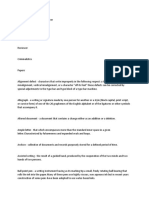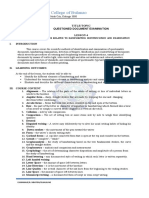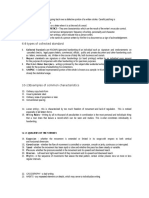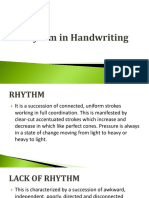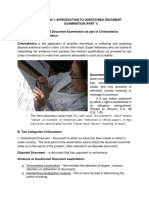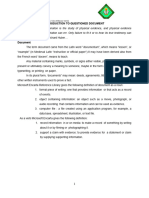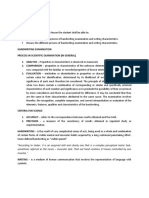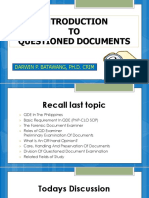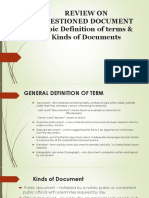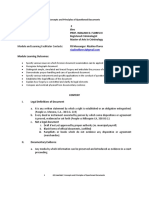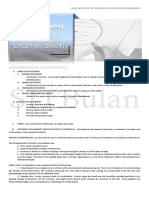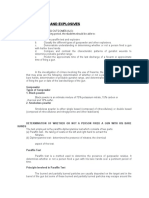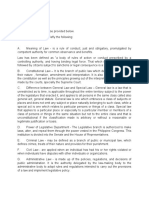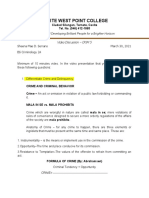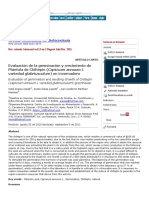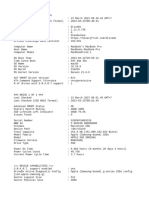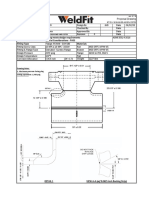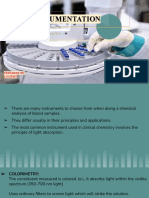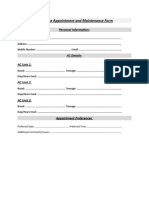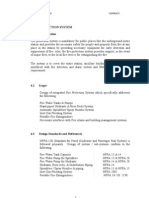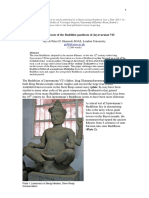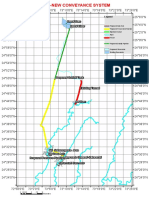Forensic 4: Questioned Document Examination - LSPU SCC
Science of Handwriting, Graphology, Graphanalysis, Psychological Analysis of
Handwriting, Graphotherapy, and Elements of Handwriting
1.1 The Significance of Writing
Writing - form of human communication by means of a set of visible marks that are related, by convention, to some
particular structural level of language
Handwriting - a visible result of the combination of mental and muscular activity with the aid of a writing instrument,
such as a pen or pencil, in the hand.
1.2 Kinds of Handwriting
a. Cursive - connected
b. Script - separated
c. Blocked - CAPITALIZED
1.3 Kinds of Muscles Which Function in the Act of Writing
Motor Coordination of Writing
- the way in which the various muscles used in writing worked together to produce written forms.
- Four groups of muscles are employed in writing: joints of the finger, wrist, elbow and shoulder
Characteristics of Motor Coordination
1. Free, rounded curves
2. Gradual changes in direction
3. Pressure, from light to heavy or heavy to light
4. Speed
5. Shading impulse
1.4 Movements in Writing
Rhythm in Handwriting
Rhythm - succession of connected uniform strokes working in full coordination
Lack of Rhythm - succession of awkward, inconsistency, independent, poorly directed and disconnected motion
By studying the rhythm of the succession of strokes, one can determine if the writer normally and spontaneously or write
with hesitation.
Two Modes of Handwriting
Natural Handwriting - mode of writing done voluntarily, without any external control or no altering of its
natural execution
Disguised Handwriting - mode of writing that is trying to modify or change the usual writing habit to hide the
identity
In disguise writing, the writer may change the direction of the letters, alignment, font, size, etc.
Graphology - the study of handwriting and handwriting analysis
According to Elaine Quigley BA Hons., MBIG Dip, a leading expert graphologist, and chair of the British Institute of
Graphologists, graphology is 'brainwriting' - the handwriting comes directly from the writer in a uniquely personal and
individual way, irrespective of how the person has been taught to write: an expert graphologist understands the styles of
the different countries and languages and makes allowances for 'taught' influences. Also largely irrelevant to the actual
analysis is the content of the written text.
JAM2020
� Forensic 4: Questioned Document Examination - LSPU SCC
1.5 Definition of Stroke and Its Characteristics
Stroke - series of lines and curves in a single letter
- the path traced by the writing instrument on the paper or on the object where the writing is done
Terminology Concerning Stroke Characteristics:
Initial Stroke - beginning of the letters
Forms of Initial Stroke
a. upward initial stroke
b. initial stroke with a beard stroke
c. downward initial stroke
d. initial stroke with a spur stroke
e. curved upward stroke
f. initial stroke with flourishes
Connecting Strokes - Stroke that connects letters in cursive writing
a. Arcade - rounded strokes to the upstroke with a flowing curve swinging from left to right.
b. Garland - links the downward stroke to the upstroke with a flowing curve swinging from left to right
c. Angular Connective Form - where the downward strokes and upward stroke meet directly that forms angular
connection
- this type of connection imposes a check in the continuity of movement characterized by an abrupt stop and start
each turning point
d. Threadlike Connective Form - the joining of downward and upward strokes is slurred to a threadlike tracing or where
rounded turns used at the both top and bottom produce a double curve
Terminal Stroke - ending of a letter
Forms of Ending Stroke
a. upward tapering of terminal stroke
b. downward blunt terminal stroke
c. blunt horizontal terminal stroke
d. tapering curved downward terminal stroke
Kinds of Terminal Stroke
a. Flying or Tapering Terminal Stroke - when the width of the stroke diminishes in size as the momentum of the writing
ends.
b. Blunt Terminal Stroke - diminishes abruptly
Arc/ Arch - a curved formed inside the top curve of the loop, as in lower case (minuscule) "h", "m", "n", "p". Any arcade
form in the body of a letter found in small letter found in small letters which contains arches.
Ascender - the top portion of a letter or upper loop
Baseline - in a ruled paper, can be imaginary alignment of writing or where the writing rest
Beaded - Prelim embellished initial stroke, which usually occurs in capital letters
Beard - rudimentary initial upstroke of a letter
Blunt - the beginning and ending stroke of a letter
Body - the main portion of the letter, minus the initial of the stroke
JAM2020
� Forensic 4: Questioned Document Examination - LSPU SCC
Bowl - a fully rounded oval or circular form on a letter complete into "O"
Buckle/Buckle knot - a loop made as a flourished which is added to the letters as in lower case (minuscule)"k" and "a" or
in upper case letters "A", "K", "P"
- the horizontal end loop stroke that are often used to complete a letter
Cacography - bad writing
Calligraphy - the art of beautiful writing
Descender - opposite of ascender, the lower portion of a letter
Diacritic - "t" crossing and dots of the letter "i" and "j"
- The matter of Indian script are also known as "diacritic signs"
- an element added to complete a certain letter, either a cross bar or a dot
Ending/Terminate Stroke of Toe - the end stroke of a letter
Eye/Eyelit/Eyeloop - small loop or curved formed inside the letter
- this may occur inside the oval letters "a", "d", "o"
Foot - the lower part of the letter which rest the baseline
Habits - any repeated elements or details, which may serve to individualize writing
Hesitation - the term applied to the irregular thickening of ink which is found when writing slows down or stop while the
pen take a stuck in position
Hiatus/Pen Jump - a gap occurring between continuous strokes without lifting the pen such us occurrence duet to speed.
- special form of pen lift
Hook - the minute curve or an ankle, which often occurs at the end of the terminal strikes
- sometimes occur at the beginning of initial stroke
Hump - uper portion of its letter "m", "n", "h", "k" and the rounded outside of the top of the bend stroke or curve in small
letter
Knob - the extra deposit of ink in the initial and terminal stroke due to the small withdrawal of the pen to the paper
Ligature/Connection - the stroke that connects two stroke of letter
Long Letter - those letter with both upper and lower loops
Loop - an oval curve found on the lower case letter
- may be blind or open, a blind loop is usually the result of the ink having filled the open space
Majuscule - upper case letters
Minuscule - lower case letters
Movement impulses - refer to the continuity of stroke force writing is usually produced by disconnected and broken
movements more motion or movement impulses than genuine writng
Oval - the portion of the letter that is in formal shape
Patching - retouching or going back over a defective potion of a written stroke
- careful patching is common defect on forgeries
Pen Lift - an interruption of a stroke caused by removing the writing instrument in the paper
Retrace/Retracing - any part of a stroke which is super imposed upon the original stroke
- any stroke that goes back over a another writing stroke
JAM2020
� Forensic 4: Questioned Document Examination - LSPU SCC
Shoulder - outside portion of the top curve
Spur - a short initial or terminal stroke
Staff - any major long downward stroke of a letter
Stem or Shank - the upright long downward stroke
Tick/Hitch - any short stroke, which usually occurs at the top of the letters
Tremor - a writing weakness portrayed by irregular shaky strokes
Physiological Basis of Handwriting
Cortex - part of the brain
Writing Instrument - (Pen, Pencil etc) Serves as an extension of the hand
Kinds of Movement
a. Finger Movement - the thumb, the first, second and slightly the third fingers are in actual motion
- most usually employed by children and illiterates
b. Hand Movement - produced by the movement or action of the whole hand and arm with the wrist as the center of the
force
c. Forearm Movement - the movement of the shoulder, hand and arm with the support of the table
d. Whole Forearm Movement - action of the entire arm without resting, e.g blackboard writing
Handwriting analysis - a tedious and methodical process that relies on extensive knowledge of the way people form
letters, which characteristics of letter formation are unique and the physiological processes behind writing - the ways in
which a person's fine-motor skills can affect his or her handwriting and leave clues about the author's identity
JAM2020


